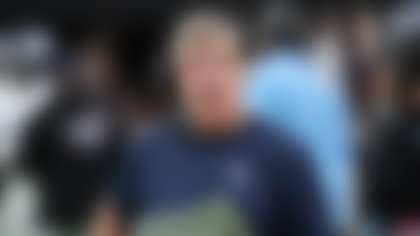Third in three-part series that looks at the NFL's process for "How a Hit Becomes a Fine."
By Hilary Guy, NFL Media producer
You must clear at least four security checkpoints to access the NFL's Officiating Command Center on game days. Even if you're lucky enough to make it inside the 42-by-36-foot room on the fifth floor of the league's New York headquarters, you need vice president of officiating Dean Blandino's permission to stay.
NFL Media had that permission Sunday and quickly found there isn't a better place to watch football. Every broadcast of every game can be viewed on the 46 monitors in the room. Everywhere you look, there's a television. What you don't see or hear is any cheering or celebrating, any jeering or jerseys.
Sundays are serious business inside the command center, and Blandino runs the show. Also in the room are 10 to 15 other people: Senior director of officiating Alberto Riveron, executive vice president Ray Anderson (who pops in and out), vice president of football communications Michael Signora and loggers who are assigned to each game.
The loggers work in the league office and have gone through training sessions to know how to properly follow games. They listen to the announcers in each broadcast and monitor every time they bring up officiating rules. If the announcers get something wrong, the loggers alert Blandino, who calls the TV truck directly and sets the network straight. Loggers also constantly populate a spreadsheet about the game, recording anything that involves player safety: injuries, potentially illegal hits, noteworthy calls or flags, instant-replay reviews. Blandino and Riveron mainly watch the games on two large monitors at the head of the room, but when a particularly noteworthy play occurs, they walk over to the specific logging station and review it again. More "Big Brother" than sports bar, the NFL's play-review process starts here.
It's important to note that Blandino and his team don't make any decisions that affect the outcome of any game. Those are made on the field with the referee, the seven other on-field officials and the replay official. Blandino doesn't even call the replay booth during the game. On game day, the play-review process is just about monitoring, cataloguing and making sure there are no surprises.
Throughout the day, Blandino often says "pull that play for the commissioner's tape" or "the competition committee" or "the coach's tape" or "Sunday night," tagging them in different categories for review. After the games end, Blandino puts together a reel of noteworthy plays -- including serious injuries and illegal hits -- for NFL Commissioner Roger Goodell and other league executives. Although the commissioner doesn't play a role in the on-field review and subsequent player discipline process, Blandino makes sure he's aware of everything, in case Goodell receives a phone call from an owner or a general manager.
"It's important he has all the information, when he does get that phone call," Blandino said.
As Blandino and his team watched, Randall Cobb caught a pass from Green Bay Packers quarterback Aaron Rogers and started to turn upfield, and Baltimore Ravens safety Matt Elamswooped in with a shot on the receiver's right knee. There was no penalty on the play -- it was a legal hit -- but the game announcers went wild. Blandino scrutinized the play in the command center and pulled it for the NFL Competition Committee to review.
"That's a play that we will catalogue. It's a player injury," Blandino said. "And we'll look at that in the offseason with the competition committee so they can look at it and determine, 'Do we need to make a rule change -- to prevent that type of injury?' "
The next morning, in the same room, Blandino presents a selection of his noteworthy plays to league executives, including Merton Hanks, the league's vice president of football operations and a nine-year NFL veteran. Each play is reviewed and discussed. When Blandino gets to Detroit Lions defensive tackle Ndamukong Suh's hit on Cleveland Browns quarterback Brandon Weeden -- which wasn't flagged on the field but was flagged in the command center for further review -- Blandino won't even refer to Suh by name. It's simply "No. 90."
By the end of the day, Blandino passes the baton to Hanks, whose job is to solely determine if "a player's act is at a level of egregiousness that warrants further discipline from repeating the act in the future." On Tuesdays, Hanks reviews the film of every violation submitted to him by the officiating department. However, if he notices a play that Blandino and his team might have missed, which he says is "very rare," Hanks has the ability to refer it back to the officiating team to determine if it's in fact a foul.
Hanks sits in his office for hours at a time and looks at film.
"You want to make sure that you have all the angles, that you're actually seeing what you think you're seeing," he said. "Football people will understand this when I say this. I don't want to be seeing ghosts."
By Tuesday night, Hanks makes his decisions on player fines and suspensions.
One of the key aspects of the play-review process is that when a penalty is called on the field, it doesn't always lead to a fine from the league offices. But when a penalty is not called, a player still might pay. Hanks' verdicts from Week 6 are prime examples of this. Suh was fined $31,500 for his hit on Weeden, which wasn't flagged. Elam, who wasn't penalized for his hit on Cobb, wasn't fined.
It's the NFL's justice system at work. This Sunday, the monitors in the shiny command center will flicker on, and the process will start all over again.



